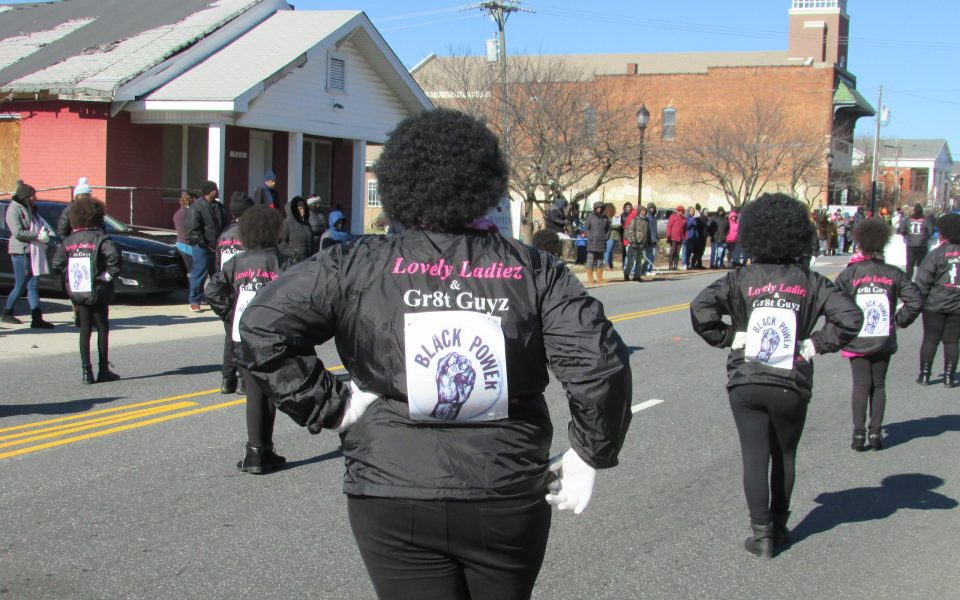After parking on Bragg Street and
making a final swipe at my 5-year-old’s runny nose with a length of TP, we make
our way up to Martin Luther King Jr. Drive, and survey the scene near the
culmination of the anticipated parade.
We gravitate to the Wilbur Mapp bust
of King, displaced from a burgeoning strip of South Elm Street by a 9-11
memorial and relocated to section of the Downtown Greenway in Ole Asheboro
among monuments to local heroes like Nettie Coad and Dorothy Brown. My daughter
and a classmate exclaim, “Martin Luther King!” and I wonder exactly what the name
means to them.
I struggle with the way King’s
message is often distorted when it’s repackaged for children — celebrating a
“dream” that becomes more about individual accomplishment than collective
progress, a commitment to nonviolence that verges on capitulation to
oppression, or color-blindness as a blanket refusal to take responsibility for
racism. If anything, I want her to take away the importance of black pride and
the necessity of struggle.
When she reads the “Black lives matter” flag hanging at the entrance of our church, she examines the words in the manner one might name dinosaurs or planets. The sense of abstraction in her engagement with the slogan breaks my heart. Despite the fact that her mother, her grandmother, godmother and her favorite cousin are all black, I have to remind her that she also is black. And white. But no less black. She seems dubious. And yet, color is hardly neutral. She seems to sense that black is not considered desirable.
From the White House and our city to
our household, white supremacy and internalized black inferiority reigns, no
matter how mightily we struggle against it.
As we wait for the parade, I applaud
the young man carrying the African liberation flag who chides those complaining
about the biting cold, noting that this is nothing compared to the snarling
dogs and firehoses that people went up to win freedom. But I also can’t argue
with my daughter, who is telling me it isn’t fun for me to hold her hand when
she wants to play instead of standing by my side.
The parade delivers. It’s a
spectacle reinforcing better than any speech could that we’re “tied together in
the single garment of destiny.” The shower of candy is the main event for my
5-year-old, but she’s also impressed by the woman who calmly walks up and hands
her a pencil. She doesn’t pay any attention to the politicians waving from the
stately motorcade, but we both delight in the classic cars — the late ’40s
Studebaker pickup, the magnificent ’57 Chevy Bel Air and the super-cool ’70s
low-rider that looks like a radiant sled.
There are high school marching bands;
we caught Western Guilford and Smith, before the cold finally got the best of
us, and a contingent of Bennett Belles. And, of course, step teams; the Lovely
Ladiez & Gr8t Guyz’ “black power” routine is a highlight. They make us
proud, and exalt education and creativity. They make us want to belong to a
team, and aspire to excellence.
The police officers blocking the
parade route with their cruisers also have a place in the panorama, as
estranged as the relationship between the police and the community might be.
We exchange greetings with the
parade participants. We may not know each person, but we’re part of this collective,
flaws and all.
If all this sounds Pollyannaish and mushy,
it’s because my sober, grownup analysis is chafing against the responsibility
of instilling hope in children. Even Sharon Hightower, the District 1
representative on Greensboro City Council, reflects in a Facebook update: “This
is MLK Jr. Holiday weekend. How can we even celebrate it when the Dream keeps
getting crushed? Still much work to do.”
There’s a lesson from King’s “Letter from a Birmingham Jail” that will have to wait. I hope that like King, my girls, including the one who is barely a month old, will beg God to forgive them for being “patient with anything less than brotherhood [and sisterhood].”
As King told the “white moderate”
clergy who expressed reservations about his campaign of nonviolent direct
action in Birmingham, “When you are harried by day and haunted by night by the
fact that you are a Negro, living constantly at tiptoe stance, never knowing
what to expect next, and plagued with inner fears and outer resentments; when
you are forever fighting a degenerating sense of ‘nobodyness’ — then you
will understand why we find it so hard to wait. There comes a time when the cup
of endurance runs over and men are no longer willing to be plunged into an
abyss of injustice where they experience the bleakness of corroding despair. I
hope, sirs, you can understand our legitimate and unavoidable impatience.”
Join the First Amendment Society, a membership that goes directly to funding TCB‘s newsroom.
We believe that reporting can save the world.
The TCB First Amendment Society recognizes the vital role of a free, unfettered press with a bundling of local experiences designed to build community, and unique engagements with our newsroom that will help you understand, and shape, local journalism’s critical role in uplifting the people in our cities.
All revenue goes directly into the newsroom as reporters’ salaries and freelance commissions.


Leave a Reply